 W
WThere are typically two types of clothing worn in Japan: traditional clothing known as Japanese clothing , including the national dress of Japan, the kimono, and Western clothing , which encompasses all else not recognised as either national dress or the dress of another country.
 W
WThe Textile Culture and Ukiyo-e Art Museum – Amuse Museum , or simply Amuse Museum, is a private museum specializing in Japanese textile culture and ukiyo-e. It opened on 1 November 2009 in Asakusa, Tokyo, not far from Ueno Park, where multiple other museums are located.
 W
WAuxiliary armour in a set of Japanese armour are optional pieces worn by the samurai class of feudal Japan in addition to the traditional six armour components.
 W
WBoro (ぼろ) are a class of Japanese textiles that have been mended or patched together. The term is derived from the Japanese term "boroboro", meaning something tattered or repaired. The term 'boro' typically refers to cotton, linen and hemp materials, mostly hand-woven by peasant farmers, that have been stitched or re-woven together to create an often many-layered material used for warm, practical clothing.
 W
WThe official court dress of the Empire of Japan , used from the Meiji period until the end of the Second World War, consisted of European-inspired clothing in the Empire style. It was first introduced at the beginning of the Meiji period and maintained through the institution of the constitutional monarchy by the Meiji Constitution, and represented the highest uniforms in use at the time. Uniforms for members of the kazoku peerage and civil officials were officially set.
 W
WFundoshi (ふんどし/褌) is the traditional Japanese undergarment for adult males, made from a length of cotton. Before World War II, the fundoshi was the main form of underwear for Japanese adult males. However it fell out of use quickly after the war with the introduction of new underwear to the Japanese market, such as briefs and boxer briefs.
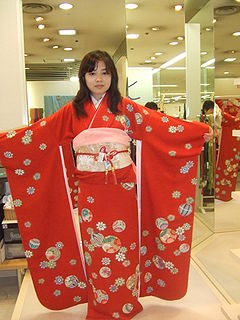 W
WA furisode is a style of kimono distinguishable by its long sleeves, which range in length from 85 cm (33 in) for a kofurisode }, to 114 cm (45 in) for an ōfurisode . Furisode are the most formal style of kimono worn by young women in Japan.
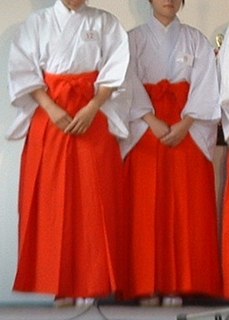 W
WHakama (袴) are a type of traditional Japanese clothing. Originally stemming from the trousers worn by members of the Chinese imperial court in the Sui and Tang dynasties, this style was adopted by the Japanese in the form of hakama in the 6th century. Hakama are tied at the waist and fall approximately to the ankles. They are worn over a kimono specially adapted for wearing hakama, known as a hakamashita.
 W
WHanten , a short winter coat, is an item of traditional Japanese clothing. The coat started to be worn, especially by the common people, in the 18th century during the Edo period.
 W
WThe haori (羽織) is a traditional Japanese hip- or thigh-length jacket worn over a kimono. Resembling a shortened kimono with no overlapping front panels, the haori typically features a thinner collar than that of a kimono, and is sewn with the addition of two thin, triangular panels at either side seam. The haori is usually tied at the front with two short cords, known as haori himo, which attach to small loops sewn inside the garment.
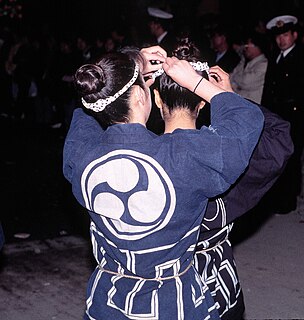 W
WA happi (法被/半被) is a traditional tube-sleeved Japanese coat, usually worn only during festivals. Happi typically feature symbols and/or text on the lapels, with a larger design on the back of the coat, typically the name or the festival or the participating association; the kanji for festival may also be present.
 W
WHaramaki are items of Japanese clothing that cover the stomach. They are worn for health and fashion reasons.
 W
WScholars agree that Japanese armour first appeared in the 4th century, with the discovery of the cuirass and basic helmets in graves. It is thought they originated from China via Korea. During the Heian period (794-1185), the unique Japanese samurai armour ō-yoroi and dō-maru appeared. The Japanese cuirass evolved into the more familiar style of body armour worn by the samurai known as the dou or dō, with the use of leather straps (nerigawa), and lacquer for weatherproofing. Leather and/or iron scales were also used to construct samurai armours, with leather and eventually silk lace used to connect the individual scales (kozane) of these cuirasses. In the 16th century, Japan began trading with Europe, during what would become known as the Nanban trade. This was the first time matchlock muskets were imported, and as they became mass-produced domestically, samurai needed lighter and more protective armour. As a result, a new style of armour called tosei-gusoku (gusoku), which means modern armour, appeared. When a united Japan entered the peaceful Edo period, samurai continued to use both plate and lamellar armour as a symbol of their status.
 W
WThere are typically two types of clothing worn in Japan: traditional clothing known as Japanese clothing , including the national dress of Japan, the kimono, and Western clothing , which encompasses all else not recognised as either national dress or the dress of another country.
 W
WA jinbei (甚平) is a traditional set of Japanese clothing worn by men, women and children during summer. Consisting of a side-tying, tube-sleeved kimono-style top and a pair of trousers, jinbei were originally menswear only, though in recent years, women's jinbei have become popular.
 W
WJōe (浄衣) is a garment worn in Japan by people attending religious ceremonies and activities, including Buddhist and Shinto related occasions. The jōe is essentially a white kariginu, traditional hunting robes worn by nobles during the Heian period.
 W
WThe jūnihitoe , more formally and historically known as the itsutsuginu-karaginu-mo (五衣唐衣裳), is a style of formal court dress first worn in the Heian period by noble women and ladies-in-waiting at the Japanese Imperial Court. The jūnihitoe was composed of a number of kimono-like robes, layered on top of each other, with the outer robes cut both larger and thinner to reveal the layered garments underneath. These robes were referred to as hitoe, with the innermost robe - worn as underwear against the skin - known as the kosode. Hakama were also worn as underwear with the kosode; over time, the two would gradually become outerwear, with the kosode eventually developing into the modern-day kimono.
 W
WKanzashi (簪) are hair ornaments used in traditional Japanese hairstyles. The term "kanzashi" refers to a wide variety of accessories, including long, rigid hairpins, barrettes, fabric flowers and fabric hair ties.
 W
WA kappōgi is a type of smock, originating in Japan. First designed to protect kimono from stains when cooking, it has baggy sleeves with gathered cuffs terminating just after the elbow, and the torso comes down to the wearer's knees. It closes by means of strips of cloth that are tied at the back of the neck and waist. It is particularly used when cooking and cleaning.
 W
WKāṣāya are the robes of fully ordained Buddhist monks and nuns, named after a brown or saffron dye. In Sanskrit and Pali, these robes are also given the more general term cīvara, which references the robes without regard to color.
 W
WKate-bukuro a commonly used component within samurai attire during periods such as the Sengoku period of Japan. A Kate-bukuro was a provisional bag used by the samurai class and their retainers. For ordinary officers however, these provisional bags had been called by the name, Koshi-zuto. These types of bags were made of twisted paper strings within the style of fine basketwork, and measures around 1 shaku to 9 sun. These bags will then be carried within the right side of the waist. Another bag is also advised to be carried, which is 3 or 4 go of rice that is raw. Baked rice is also regularly employed when amongst cold weather due to the emission of heat.
 W
WThe Khalili Collection of Kimono is a private collection of Japanese kimono assembled by the British-Iranian scholar, collector and philanthropist Nasser D. Khalili, containing more than 450 items. It is one of eight collections assembled, published and exhibited by Khalili, each of which is considered to be among the most important collection within their respective fields.
 W
WThe kimono is a traditional Japanese garment and the national dress of Japan. The kimono is a T-shaped, wrapped-front garment with square sleeves and a rectangular body, and is worn left side wrapped over right, unless the wearer is deceased. The kimono is traditionally worn with an obi, and is commonly worn with accessories such as zōri sandals and tabi socks.
 W
WThe Kokumin-fuku (国民服) was the European-style men's civil attire introduced in Japan in 1940 during World War II.
 W
WA kosode is a type of short-sleeved, kimono-style garment that was traditionally worn in Japan until the latter years of the Edo period.
 W
WKyahan are cloth leggings worn by the samurai class and their retainers in feudal Japan. In Japanese the word is also used for western soldier's gaiters.
 W
WLoose socks are a style of baggy sock worn by Japanese high school girls, as part of kogal culture. This style of socks has also become popular among American teens and college students who are fans of Japanese anime and manga. These socks come in a variety of styles—defined by the knitting pattern of the upper. The two most popular styles are the traditional 2×2 rib knit (pictured) and tube-style loose socks, which are thigh-high length tube socks worn pushed down around the ankles. A skin-safe body adhesive popularly known as "sock glue" can be used to affix the uppermost part of the sock to the calf so that the entire sock will not bunch downward and spoil the look.
 W
WA mino (蓑) is a traditional Japanese garment, a raincoat made out of straw. Traditional mino are an article of outerwear covering the entire body, although shorter ones resembling grass skirts were also historically used to cover the lower body alone. Similar straw capes were also used in China, Vietnam and Korea.
 W
WAn obi (帯) is a belt of varying size and shape worn with both traditional Japanese clothing and uniforms for Japanese martial arts styles. Originating as a simple thin belt in Heian period Japan, the obi developed over time into a belt with a number of different varieties, with a number of different sizes and proportions, lengths, and methods of tying. The obi, which once did not differ significantly in appearance between men and women, also developed into a greater variety of styles for women than for men.
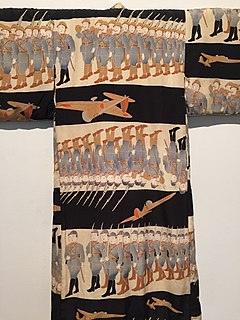 W
WKimono that carried designs depicting scenes from contemporary life became popular in Japan between 1900 and 1945. Now known as omoshirogara , during WW2, many of these designs depicted and reflected the military and political actions of Japan during its involvement in the war (1931-1945), and are commonly referred to as 'propaganda kimono'.
 W
WA rakusu (絡子) is a traditionally Japanese garment worn around the neck of Zen Buddhists who have taken the precepts. It can also signify Lay Ordination. It is made of 16 or more strips of cloth, sewn together into a brick-like pattern by the student during their period of preparation for their jukai or ordination ceremony.
 W
WSamue (作務衣) is the work clothing of Japanese Zen Buddhist monks, worn when engaged in samu.
 W
WThe Japanese school uniform is modeled in appearance similar to that of the European-style naval uniforms. It was first used in Japan in the late 19th century, replacing the traditional kimono. Today, school uniforms are common in many of the Japanese public and private school systems. The Japanese word for this type of uniform is seifuku (制服).
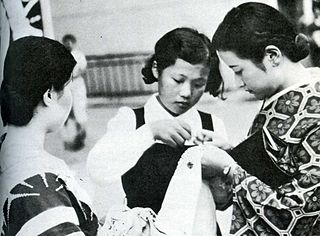 W
WA Senninbari or one thousand stitch is a belt or strip of cloth stitched 1000 times and given as an amulet by Japanese women to soldiers going away to war.
 W
WThe hu is a flat scepter of Chinese origin. It is also currently or was historically used in Japan, Korea, Vietnam and Ryukyu. It is known as the shaku in Japan, and is worn as part of the sokutai ceremonial outfit.
 W
WOutside of Japan, a Shitagi , a type of shirt worn by the Samurai class of feudal Japan when they were wearing full armour.
 W
WThe sokutai (束帯) is a traditional Japanese outfit worn only by courtiers, aristocrats and the emperor at the Japanese imperial court. The sokutai originated in the Heian period, and consists of a number of parts, including the ho, shaku (笏), a flat ritual baton or sceptre, and the kanmuri (冠), a cap-shaped black lacquered silk hat with an upright pennon decorated with the imperial chrysanthemum crest.
 W
WA tasuki is a fashion accessory used for holding up the long sleeves of the Japanese kimono. It is a sash made from either cloth or cord that loops over each shoulder and crosses over the wearer's back. The bottom of the kimono sleeves can then be tucked into the loop, holding them back for convenience and functionality.
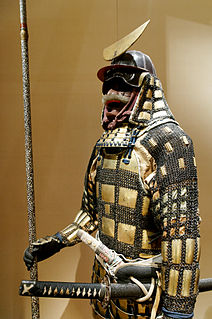 W
WTatami (畳具足), or tatami gusoku and gusoku, was a type of lightweight portable folding Japanese armour worn during the feudal era of Japan by the samurai class and their foot soldiers (ashigaru). The Tatami dō or the tatami katabira were the main components of a full suit of tatami armour.
 W
WTobi trousers or tobi pants are a type of baggy pants used as a common uniform of tobi shokunin, construction workers in Japan who work on high places. The pants are baggy to a point below the knees, abruptly narrowing at the calves so as to be put into the footwear: high boots or jika-tabi.
 W
WTsujigahana (辻ヶ花) is a Japanese fabric dyeing technique that originated in the Muromachi period.
 W
WUwa-obi (上帯) a type of belt/sash that was worn by the samurai class and their retainers in feudal Japan. The uwa-obi was used to attach the sageo of the sword or swords worn by a samurai in order to secure it, other weapons and equipment would be tied to the uwa-obi as well. The uwa-obi was made from linen and cloth made of cotton, it would be wound two to three times around the body when worn. When the uwa-obi was worn with the attire or armour of the samurai, it would first be folded in two, then twisted and then a piece of leather was placed within the centre. This method was used to find the middle of the uwa-obi in a dark area. When putting on the uwa-obi, it was worn with the center in the front of the Dou (dō), then the two ends would be wound around the waist area and back to the front, the uwa-obi would be tied in front rather firmly with the hanamusubi knot.
 W
WOutside of Japan, an uwagi (上着/上衣) means a kimono-like jacket worn in Japan. It is believed as most familiar as the top half of a martial arts uniform.
 W
WA yukata is an unlined cotton summer kimono, worn in casual settings such as summer festivals and to nearby bathhouses. Originally worn as bathrobes, their modern use is much broader, and are a common sight in Japan during summer. Though yukata are traditionally indigo and white in colour, modern yukata commonly feature multicoloured designs, and are designed to be machine washable. They are similar in appearance to the nemaki, a unisex short-sleeved kimono-like garment worn by guests at traditional inns.